Kailas – Tibet: 2014 г. | 2015 г.
INTERNATIONAL CENTER OF THE ROERICHSThe Second International Scientific and Public Conference
“THE KAILAS PHENOMENON AND ITS ROLE IN THE EVOLUTION OF MAN”
March 21–22, 2015
Research group of the Kailas phenomenon (Russia)
International Center of the Roerichs (Russia, Moscow)
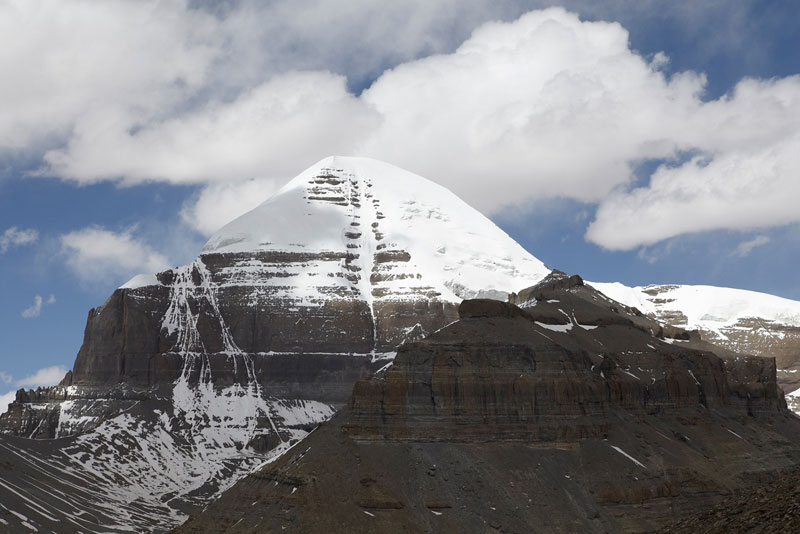 | |
The second international scientific and public conference “The Kailas phenomenon and its role in the evolution of man” has covered a range of the most thought-provoking research problems concerning cultural and natural monuments of Tibet, in particular, one of the most sacred and mysterious regions of the planet – the Kailas mountain system. A special attention was paid to such unique objects of Central Asia as the Great lakes of Tibet and ancient pilgrimage ways running along these lakes up to Mount Kailas. The main part of the conference work was devoted to the questions about the Tibetan route passed by the Roerichs during their Central-Asian expedition in 1924–1928, when some important scientific discoveries were made by the outstanding Russian thinker, historian and an artist Nicolas Roerich and his elder son, Orientalist George Roerich. Results of a recent expedition (2014) that followed these Tibetan routs, covering one of the most remote and still unexplored regions of the planet, were presented as well.
Over a hundred people from Russia, Bulgaria, Germany and India, including scientists and public figures, bearers of ancient traditions of Tibet, travelers and pilgrims, writers and filmmakers, took part in the conference work.
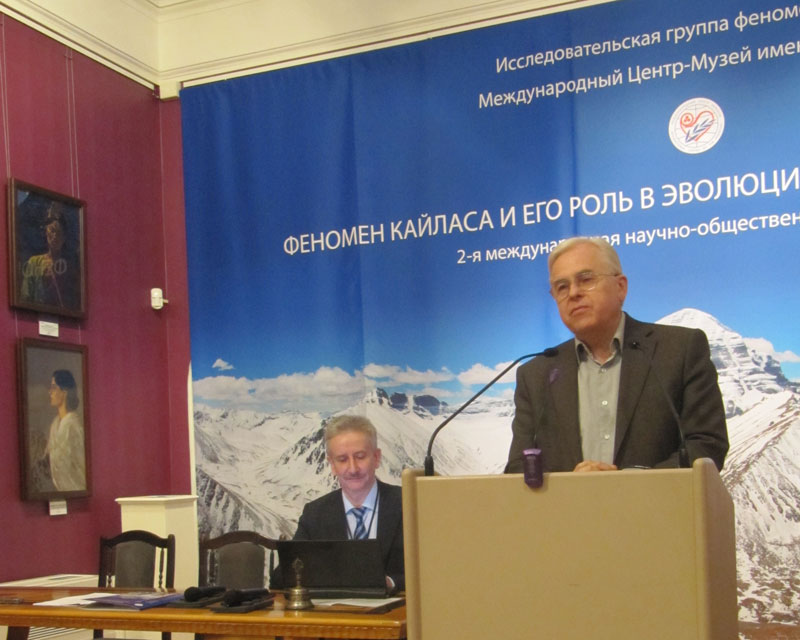 | |
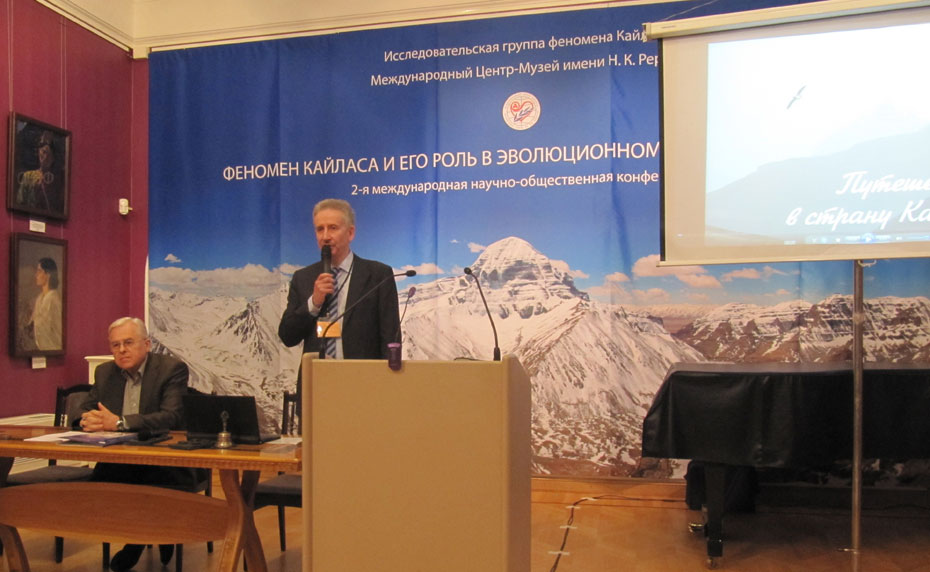 |
The conference was solemnly opened with a video about Tibet and photographs of Sergey Balalaev and Alexander Titov to the music by Richard Wagner ("Parsifal", Overture). With an opening address to conference participants spoke:
– the President of the International Center of the Roerichs and the International Committee on Preservation of the Roerichs' Heritage, Ambassador Extraordinary and Plenipotentiary Alexander P. Losyukov who expressed a great interest to the issues of the conference, thanked the participants and wished them a successful and fruitful work;
– the Head of the Research group of the Kailas phenomenon, Sergey Balalaev who highlighted the aims and objectives of the forthcoming work and noted that such conferences had never been held before anywhere else in the world.
23 reports were presented at the conference. They covered a wide range of topics on research methodology, cultural and historical aspects, including the problem of the Great Migration, spiritual experience of pilgrims, mythology and study of ancient sources, geological and geographical issues, etc.
Conference routine was beautifully enriched by Oleg Martynov's documentary "Tibet – Kailas. Radiance of Being" (2013), Sergey Balalaev's video-footage from his expedition “On the route of the Central-Asian expedition of the Roerichs” (2014), and a musical video-sequence about Tibet, which harmoniously complemented the impressions of the participants about this beautiful and in many ways still mysterious region.
For the first time in the history of conferences held at ICR in Moscow, inhabitants of other regions of Russia had the opportunity to become participants of the conference “The Kailas phenomenon and its role in the evolution of man” online. The event was held in a friendly atmosphere of a scientific research, exchange of views and fruitful discussions.
21 March, 2015 Morning session
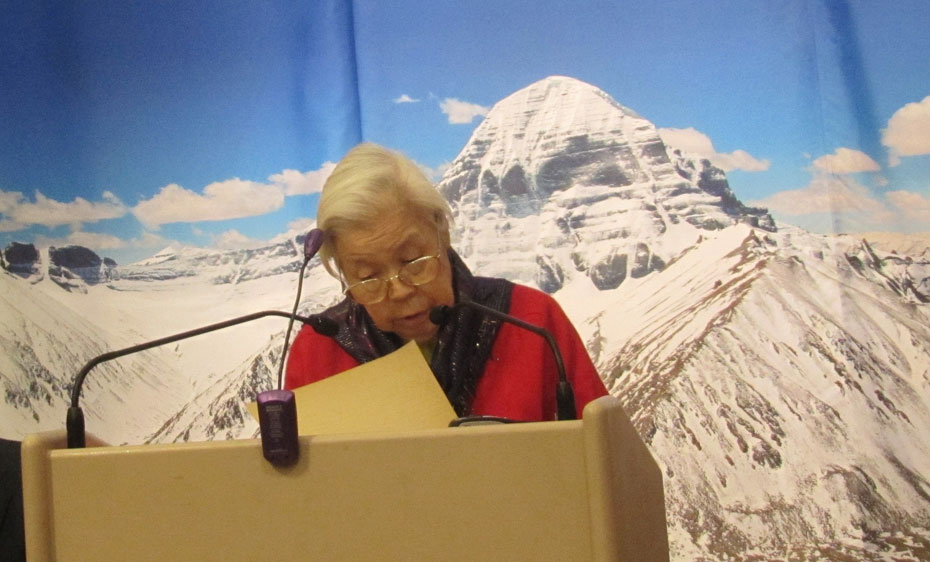 | |
Vilena S. Dylykova-Parfionovich (Russia, Moscow), an honorary participant of the conference, Candidate of Philology, Tibetologist, Sinologist, a former student of George Roerich, presented her report "Mount Kailas in Indo-Tibetan mythology". An extremely interesting fact about her creative biography is that she is one of the authors of the 11-volume “Tibetan-Russian-English dictionary with Sanskrit parallels” and other scientific works, in particular devoted to the study of Kalachakra. Vilena Dylykova-Parfionovich pointed out that Buddhist cosmogony proposed different schemes of the Universe structure, but the most famous among them represented a round Universe consisting of four continents-islands surrounded by the Outer Ocean. In the centre of the southern continent Jambudvipa identified with planet Earth, according to the ancient Indian cosmography, there is a mythical Mount Meru which is towering like the Olympus, whereas the sun, the moon and other planets are constantly rotating around it. Mount Meru as the highest mountain, or Mount Tisé, is considered to be the center of the world, “the King of the mountains” and “the Golden Mountain”. Moreover, Mount Meru is the center of both Jambudvipa and the Universe for the Tibetans. In the works of Tibetan authors, Mount Meru, or Sumeru, in most cases was called “rirep”. Mount Meru also embodies the Golden Pillar, or the World Tree, connecting heaven with earthly world. The sacred name of «Su-meru» is also the epithet of Shiva meaning "sublime", "superior". In the early literary works, the peak of Meru appears as the heaven residence of Brahma and the place which brings together the gods, sages-rishis, celestial musicians-the Gandharvas and others. The Indians and the Tibetans identify Mount Meru with Mount Kailas; Tibetologist D. Snellgrove (the UK) puts the sign of equality between Mount Meru and Mount Kailas. The ruler of Mount Kailas, who has his own residence there, is the god of wealth Kubera; the Lord living at the top of Kailas is the formidable Shiva, dwelling in this mountain paradise with his wife Uma. Indian and Tibetan Buddhists revere Kailas as a sacred mountain which is reflected in the Puranas and the great epic “Mahabharata”. An analytical review of the recorded cosmogonic myths of Old India and Tibet describing mountain peaks and glaciers located in these countries, allows us to conclude that the world's highest mountain Meru identified with Mount Kailas is a heavenly inhabitant ruling the firmament, while Mount Kailas was born on planet Earth and, being “the daughter of the Himalayas”, is located on the territory of Tibet Autonomous Region of China.
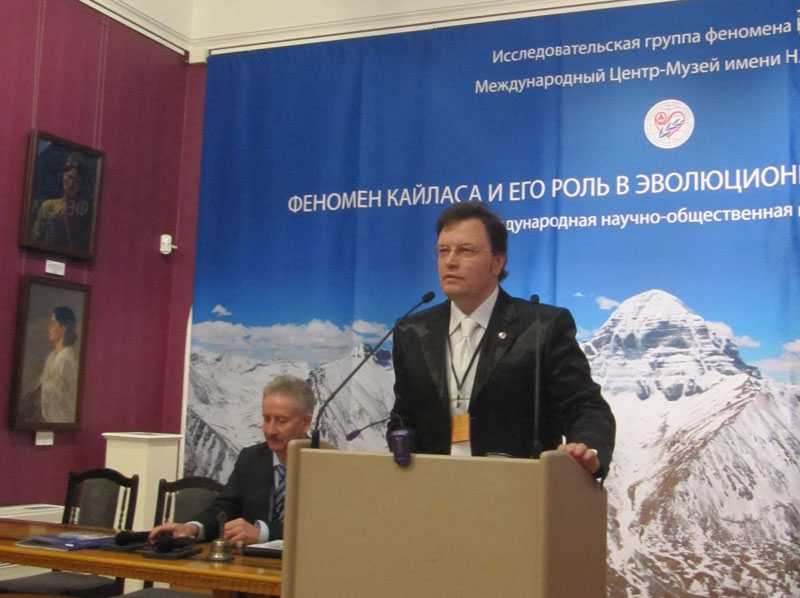 | |
Vladislav G. Sokolov (Russia, Moscow), PhD, Сulturologist, Senior Research Fellow of the United Scientific Center of Cosmic Thinking (USC CT) at the International Center of the Roerichs (ICR), Laureate of the International award named after Helena Roerich, in his report "Methodological bases of research of the Kailas phenomenon and other natural and cultural monuments of Tibeto-Himalayan region", first informed about the creation of a new scientific section “Kailas – Tibet in the light of the cosmic evolution of mankind” at the United Scientific Center; its work will be operated jointly with the Russian research group of the Kailas phenomenon. The speaker explained the structure of the section and proposed seven spheres of scientific work. However, they should not be limited, he stressed, by the region of Kailas – it is necessary to study the whole Tibet and Himalayan region and therefore, if necessary, other regions of Eurasian continent, because in the research process a number of interesting associations related to the long evolution of man might appear. Then Vladislav Sokolov suggested methodological principles for studying the Kailas phenomenon and other natural and cultural monuments of Tibeto-Himalayan region.
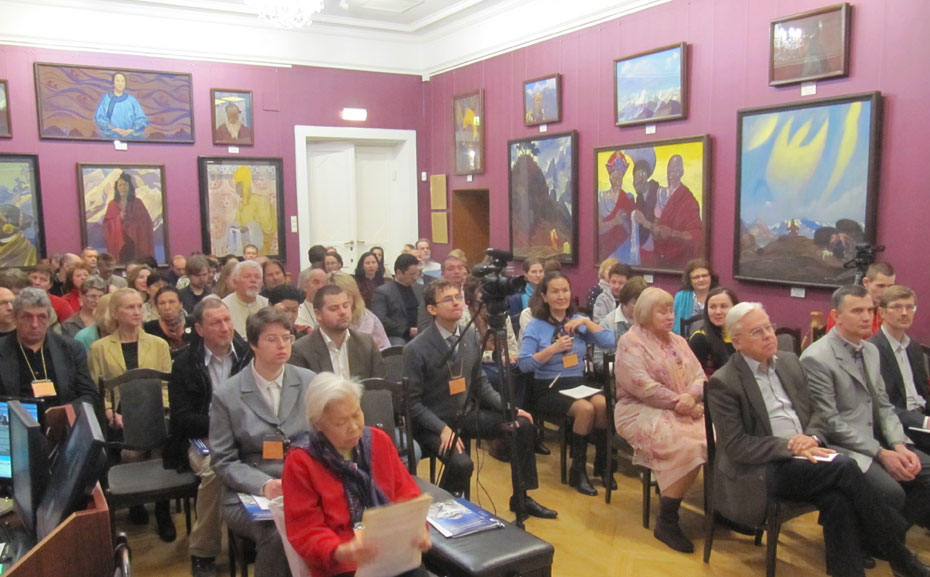 | |
Some of the ideas of this methodology. 1) Comprehension of the evolutionary significance of the region has two aspects: the first involves the study of natural objects, which are an integral part of our planet as a celestial body and link of the evolutionary chain of the Universe. Such an approach to the study of the Earth allows us to consider natural (as well as man-made) phenomena of the planet in their connection with creativity of Cosmos, and also as a unified planetary system of objects. The second aspect implies the study of the centuries-old culture of Tibeto-Himalayan region, with its central concept of man-microcosmos. These two aspects are realized in the field of cosmic thinking. 2) The creative process of Cosmos manifests itself on the planet through what we call natural objects as well as inner world of man, resulting in evolutionary actions and new knowledge. In ancient times, high knowledge came in the form of myths. The study of mythology of Tibeto-Himalayan region should be based on new approaches: firstly, over the mythological images, there is a certain reality of the multi-dimensional structure of cosmos; secondly, we must find the key to the meaning and interpretation of these mythological images. 3) It is necessary to take into consideration two main layers of antiquity: the first one – the centuries of the Buddhist period and millenniums of the pre-Buddhist epoch; the second layer is much more ancient taking its roots from the era of ancient continents with human Races that lived there, which were the creators of megalithic monuments of complicated technology that can be found in many regions of our planet. 4) Research of Kailas as well as other important phenomena of Tibet will be most comprehensive, if it is carried out in line with a new unified system of cognition, provided by synthesis of empirical research methods and meta-cognition. This new system of cognition is the basis of cosmic thinking and one of the important features of the philosophical system of Living Ethics; it would provide us the most comprehensive study of the region. 5) Study of the Kailas phenomenon and other natural and cultural sites of Tibet should be based on cosmic laws applicable for the Universe as a whole, as well as for our planet and all the aspects of human society. 6) Understanding and taking account of the leading principle of cosmic evolution which is “Teacher – Pupil”; the role of the Great Teachers of humanity in formation of the potent cultural field in Tibeto-Himalayan region is essential and decisive. 7) Understanding of the phenomenon of meta-history which wholly permeates Tibeto-Himalayan region. 8) Study of subtle human nature and the integral system “man – planet – Space”.
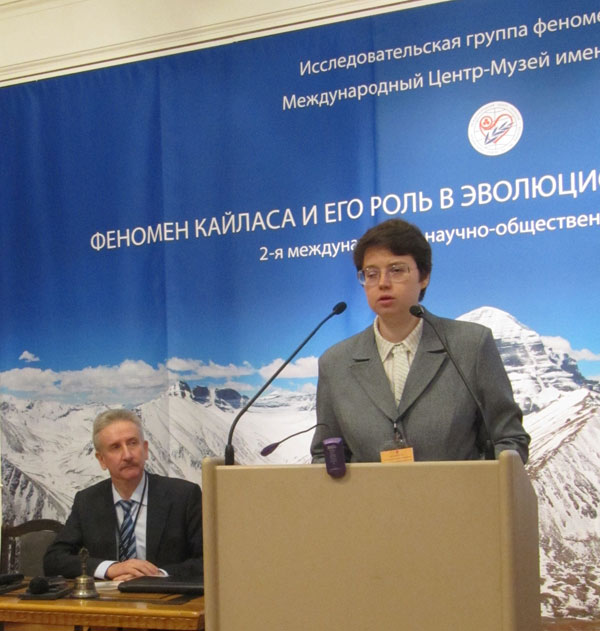 | |
Bohdana Y. Sokolova (Russia, Moscow), Candidate of Culturology, Research Fellow of the United Scientific Center of Cosmic Thinking at the International Center of the Roerichs, in her report "The Tibetan heroic Epic of King Kesar in the works of George Roerich" noted that the work of the eminent Orientalist, Philologist and Linguist George Roerich “The Tale of King Kesar of Ling” contains a unique scientific material. Its author still remains the only scholar who knew a large number of oriental languages and dialects, whereby he had the opportunity to collect and compare different versions of Geseriada and information about the traditions associated with the image of Geser (Mongolian version of Kesar). In his work, George Roerich offers the summary of Tibetan, Eastern-Tibetan (Kham), Western-Tibetan, Amdo and also Mongolian versions of the epic. He provides an extensive historiographical reference, describes the rhapsodic epic tradition, considers the image of Geser in Tibetan art. The works of George Roerich "The Tale of King Kesar of Ling" and "Tibet – the country of snow" are essential when studying Geseriada in terms of philosophical understanding of heroism as a phenomenon. Firstly, in all versions of Geseriada analyzed by George Roerich, one can find evidences linking the hero Kesar with the Supreme origin of the spiritualized Universe. And, secondly, while exploring the epic of Geser, George Roerich discovered a very important point, that is development and extension of Geseriada in the present epoch, which is a unique case in the world cultural practice, as the heroic epic is usually a finished work. A messianic character of Geseriada is in the fact that it encourages the peoples of Asia and imbues them with high energy which creates aspiration to the future. It is that aspiration, as well as deep affection for the hero and his worship, that is an essential evolutionary factor of the nation.
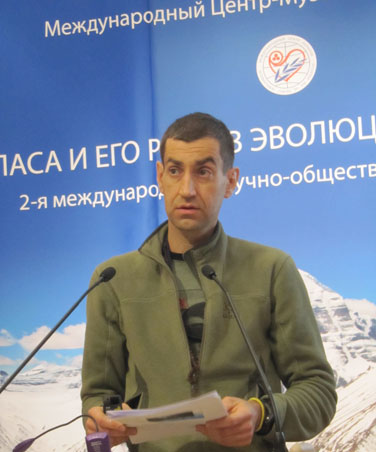 | |
Alexey V. Perchukov (Russia, Saint-Petersburg), a traveller, in his report "Exploration inside the Kailas Mandala" pointed out that, according to ancient Tibetan texts, Kailas is a giant natural mandala which can be imagined as a lotus with eight petals. The centre of the mandala is the top of the mountain, four faces of Kailas make the sides of a square, and the outer kora (circuit) forms a circle. The eight lotus petals are formed by eight river valleys beginning from the glaciers at the foot of Kailas. German researcher Wolfgang Vollmer describes this lotus-like model in detail at the example of Chakrasamvara mandala where the divine couple is surrounded by the Circle of Great Bliss and a lotus flower with eight petals. Motion in mandala occurs from the outside to the center, which can be figuratively represented as an ascent from the material to the spiritual. The first contact with Kailas usually happens during the passage of the so-called Outer Kora, which, as is known, does not directly adjoin the mountain, nor its adjacent passes. However, here raises the question of possibility of a closer circuit of the mountain with ascent to adjacent passes. Such a route would most closely match the outward aspect of the inner kora. Indian researcher of Tibet and Kailas Swami Pranavananda described the route which later received the name “Southern Traverse”. German researcher Wolfgang Vollmer, in his turn, described the so-called “Northern Traverse”. Nevertheless, nobody has ever managed to accomplish a logically complete kora via the passes directly adjacent to Kailas. Mr. Perchukov spoke in detail about his personal experience of studying Mount Kailas and the results of his research, stressing that he worked out the expedition routes on his own. The speaker described in detail several interesting routes and also spoke about the tasks of his expedition coming in 2015.
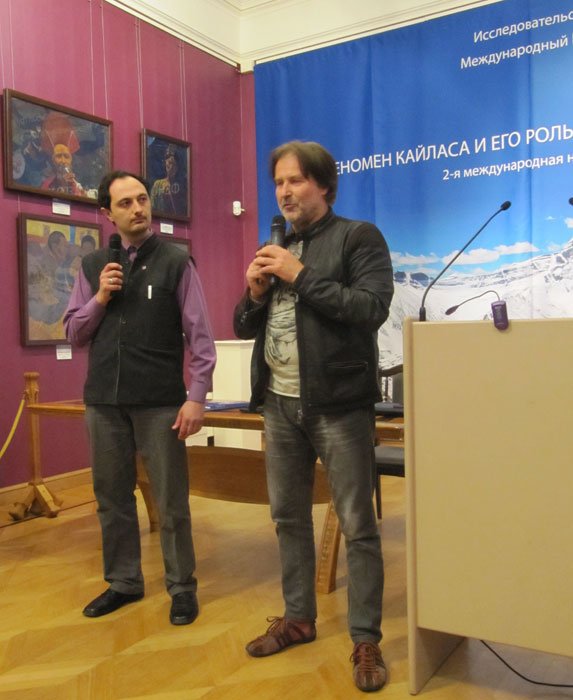 | |
| Bruno Baumann (on the right).
Translator – Areg Mekhakyan |
A true adornment of the conference was the lecture "Kailas - pilgrimage routes to the Sacred Mountain" lasted for nearly one and half hour, by the honorary member of the conference Bruno Baumann (Germany, Munich) – an outstanding traveler, expert on Tibet, producer, writer, filmmaker, photojournalist, professional mountain climber, honorary editor of "National Geographic", owner of numerous literary prizes and photo awards. It should be noted that it was the first appearance of Bruno Baumann in Russia. He is one of the first Europeans who came to Tibet at a time when Chinese government opened it to foreigners in the 80-s of the last century. This unique explorer has spent more than forty years traveling to various places of the world, including hard to reach ones – in South America, Africa, Australia, Southeast Asia, Indonesia, New Guinea, Polynesia, Central Asia, Tibet, China, Nepal, Bhutan, India (Ladakh), Pakistan, Sri Lanka, Norway and others. Bruno Baumann passed on the route of the Great Silk Road, crossed the Gobi desert alone on foot, visited remote Himalayan kingdoms, inaccessible areas of the Tibetan plateau, became the second man (after the renowned Swedish traveler and geographer Sven Hedin) who crossed the harsh desert Taklamakan in XX century. He is one of the first European explorers who reached the sources of four great rivers – the Indus, the Brahmaputra, the Sutlej and the Karnali. Mr. Baumann is the author of the book “Kailas: the sacred mountain of Tibet” recognized as the best book of travels in Germany in 2002, awarded literary prizes and translated into many languages.
 |
At the beginning of his speech, Bruno Baumann said: "I am a big admirer of Nicholas Roerich, whose books have inspired me greatly, especially his book about Shambhala." It was this book that inspired him to visit the Trans-Himalayas in the region of Kailas. For the first time he visited Tibet in 1986, and in 1987 began his first trip from Lhasa to Mount Kailas. "For me, pilgrimage is a walk on foot, shared Mr. Baumann with the audience, this is the only way you notice the beauty of nature, feel and contemplate a lot, which is impossible when you travel by car." He spoke about various aspects of his journey, about his feelings and experiences on meeting the majestic Mount Kailas. Those experiences, stressed Bruno Baumann, had a transformative influence on him and his companions. In his opinion, it is not so important how many times a person has done kora around Kailas, but is important his or her motivation. A proper motivation is spiritual, when you are doing kora not for the benefit of your own, but for the benefit of all living beings, of all mankind. Water as the source of life plays a special role in the sacrality of Kailas. Bruno Baumann noted that now, after a quarter of a century, the energetic state of Tibet has changed significantly, unfortunately, it has deteriorated because of numerous hotels and entertainment venues. Instead of turning Lhasa into an object of UNESCO protection, the old city is being destroyed and new buildings are being erected. Furthermore, Mr. Baumann said that we must not allow conversion of the surrounding areas near Kailas into Disneyland, and it will respond to the ideas of the Roerich Pact. The speech of Bruno Baumann was accompanied by a beautiful presentation – unique photos, music, ritual Tibetan singing and movies created the effect of presence in the majestic and mysterious places.
21 March, 2015. Evening session
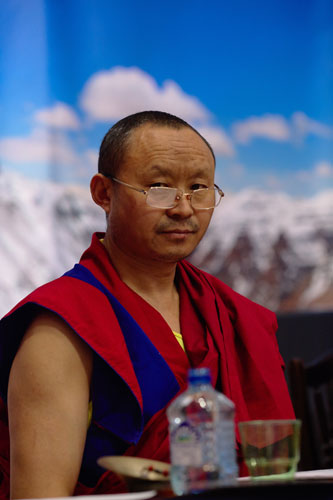 | |
Arta Lama Rinpoche (India), an honorary participant of the conference, Dzogchen Master of tradition Shang Shung Nen Gyud, came up with the topic "Mount Kang Tise (Kailas) in the Bon tradition". Arta Lama Rinpoche received his first instructions on Ngondro and Dzogchen practice from his uncle, the realized yogi Nyim Tsultrim. The Lama was a monk in a monastery Menri where he studied philosophy. He obtained many important initiations and oral instructions from different teachers as well as the unique teachings of New Bon. In a monastery Triten Norbutse in Nepal, Arta Lama received the teaching of the Four Circles of Dzogchen and studied grammar, poetry, astrology and mandala. As a bearer of the Bon tradition, Arta Lama Rinpoche began his speech with a brief historical overview that the doctrine of Bon was brought by the Buddha Tampa Shinrab who blessed Mount Kailas eighteen thousand years ago. Bon is the doctrine of complete liberation from suffering and non-return to it. Arta Lama spoke about the way Bon treats the causes of human diseases. Such causes are three: 1) wrong way of life (food, etc.); 2) causal (karmic) bonds; 3) specific negative creatures that are invisible to physical sight. At the same time, Lama told about the ways of getting rid of diseases caused by the above-mentioned reasons. Arta Lama emphasized that we must not think that the followers of Bon-po are those who eat meat and commit rituals that cause harm. Tampa Shinrab forbade sacrifices or causing harm to other creatures. Considering Mount Kailas (in Tibetan, Kon Rinpoche – "Snow Treasure") as the center of the world, Bon comprehends Kailas externally as the object similar to a stupa, and internally as the mandala of yidams – the deities. A kora around Kailas can bring various good consequences. Arta Lama also spoke about the highest achievement of Bon practices that is realization of the rainbow body. Reflecting on historical aspects of the ancient Tibetan state Shang Shung, Arta Lama noted that perhaps this country extended to the territory of modern Russia, to the area of Arkaim, where some buildings similar to Tibetan ones were found. It is curious that sixteen thousand years ago in Shang Shung, there were crafts, arts (for example, thangkas), medicine, etc.
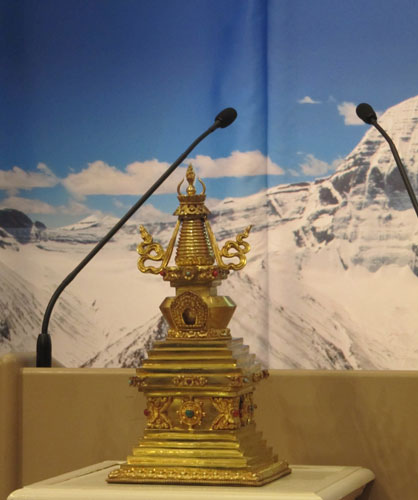 | 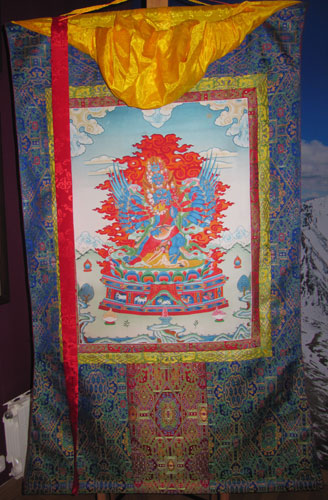 |  | 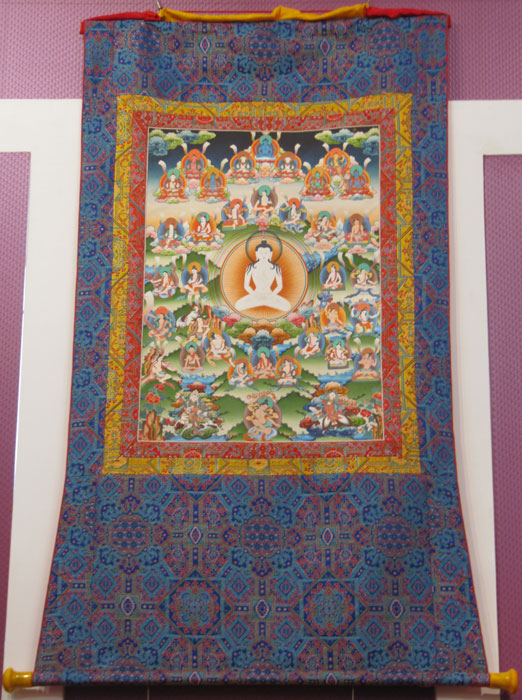 |
| Relics provided by Artalama for the conference | |||
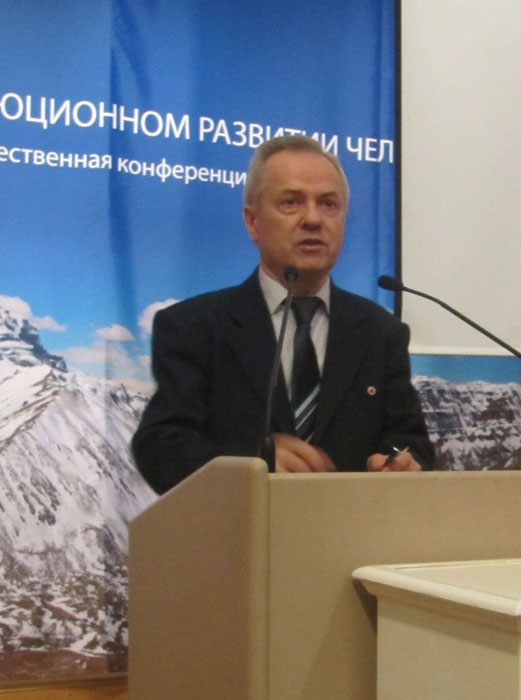 | |
Victor V. Frolov (Russia, Moscow), Doctor of Philosophy, Professor, Deputy Director for Research of the Nicolas Roerich Museum, Head of the United Scientific Center of Cosmic Thinking at the International Center of the Roerichs, in his report "The Kailas phenomenon and the new system of knowledge: to the statement of a problem" denoted the need for synthesis of empirical and metascientific reflection on the Kailas phenomenon. When studying this phenomenon, both traditional scientific methods and spiritual experience of the people who have been there have a value. The most important conditions for acquisition of knowledge about this region are a professional approach to research and relying on the new cosmic thinking. In the new theory of knowledge, subject is not distanced from object, and interpretation of the latter includes both the visible and the invisible sides of it, that is, takes into account the law of duality. Applying such system of cognition, scientists can gain new knowledge about the phenomenon of Kailas and generate more and more integral understanding of it. At the moment, an important issue is to include research findings about Kailas organically into the general range of ideas about it. The prospects of exploring of this region, according to the speaker, consist firstly in accumulation of knowledge volume about it, and secondly, in forming of a holistic picture about Kailas as a planetary and cosmic phenomenon. This view will open up new possibilities for understanding the role of this phenomenon in the evolution of mankind.
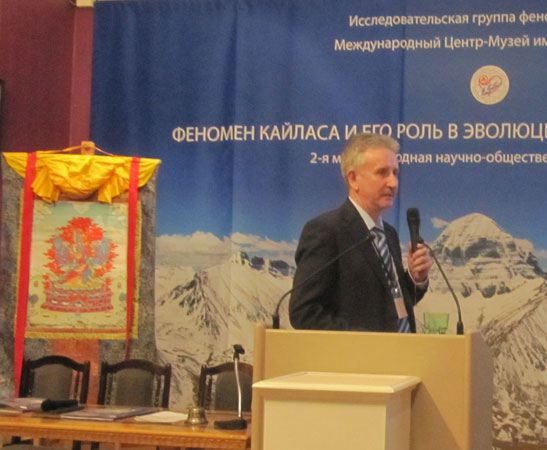 | |
Sergey Yu. Balalaev (Russia, Voronezh), Candidate of Physical and Mathematical Sciences, Head of the Research Group of the Kailas phenomenon, a traveler, organizer and participant of sixteen expeditions to Tibet, at the beginning of his report "New facts on the significance of Kailas for the evolution of mankind" reviewed the role played by this sacred mount in Tibetan and Indian religious traditions. For many centuries, Kailas has been a center of religious pilgrimage; in Sanskrit literary works, it is referred to as a place associated with divine beings and great sages; Tibetan literature of the Bon teachings and the Buddhist sources also believe that mountain to be a sacred place. Following the principle of sacred geography, namely, that everything comes from the source located in heaven to be exactly recreated on earth, the speaker presented his own interpretation of some unusual formations that can be found on the faces of Kailas. In particular, Mr. Balalaev focused on the symbolism of an astonishing, not-made-by-hand fracture located on the south face of the mountain. In that fracture, the layers are bared, as if forming a sort of thirteen-step stairs. According to the speaker, the symbolism of the crack has evolutionary aspects. In conclusion, Sergey Balalaev announced the objectives of his expedition to Kailas in 2015.
 | |
"The use of nuclear-physical methods of analysis for determining the elemental composition and age of the geological samples from the region of Mount Kailas" was the title of the report submitted by M.V. Gustova, O.D. Maslov and A.O. Khotylev working at the Laboratory of Nuclear Reactions named after G.N. Flerov of the Joint Institute for Nuclear Research (Russia, Dubna). Presenting the report, Marina Gustova noted that Kailas has a distinct pyramidal form, with its faces clearly oriented to the cardinal points. Therefore, some researchers have suggested its artificial origin. There is a hypothesis, according to which, for the construction of this kind of pyramid, there was used a natural rock formation with artificial covering for durability. In order to determine whether the objects under study be of natural or artificial origin, the determination of their elemental composition as well as their age estimation were carried out. For that purpose, the nuclear-physical methods of analysis, which include X-ray fluorescence, gamma and neutron activation, were applied. These methods were used to determine the microelemental analysis of six geological samples collected on the four faces of Mount Kailas at the altitude of 5390–5800 m. by the expeditions of Sergey Balalev in 2013–2014 years. On the basis of the results, the geological classification of the samples and their age estimation were carried out. The results of the analysis showed that the geological samples represented magmatic, plutonic and other kinds of rocks aged between 20 and 25 million years, the age of the youngest rocks be from 8 to 12 million years. These results conform well to the description of the tectonic evolution of Tibet.
| K 2 sample, western edge of Kailas, height 5390 м. Leucogranite with phlogopite (plutonic rock).
Age estimation: 6,78 – 8,46 million years ago | Multicomponent gamma activation analysis (GAA) is based on measurement of gamma activity of radionuclides which appear according to the reaction (g, n) during activating elements samples by gammas |
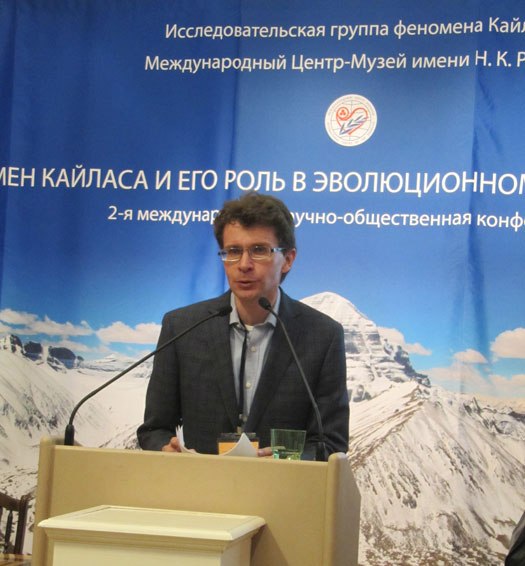 | |
Alexander V. Titov (Russia, Moscow), a member of the Research Group of the Kailas phenomenon, in his report "Kailas – the Abode of Fire Element", reviewed the symbolism of mythological and semantic concepts related to Mount Kailas. Since ancient times, Kailas has been considered to be the abode of Lord Shiva who, despite his epithet "the destroyer", was understood as bestower of happiness, a great peacemaker and creator. According to Mr. Titov, the trident of Shiva corresponds to the triple nature of man. The speaker considers that the connection of Kailas with the element of Fire can be seen, firstly, in the fact that the mount is related to the symbolism of the World Axis, as well as the World Tree, with a Serpent-Dragon living in its branches. This dragon is a symbol of the primary cosmic energy, initial motion of cosmic Fire waves symbolized by Serpent’s oscillating body shape. Another fact testifying the relationship of Kailas to the element of Fire is the shape of the mountain which is almost an exact natural pyramid. In the view of antique philosophers, crystals of Fire element have a pyramid form (Greek. "pyr" – fire, "midos" – measure). The speaker considered the pyramid as a model of cosmic evolution.
22 March, 2015. Morning session
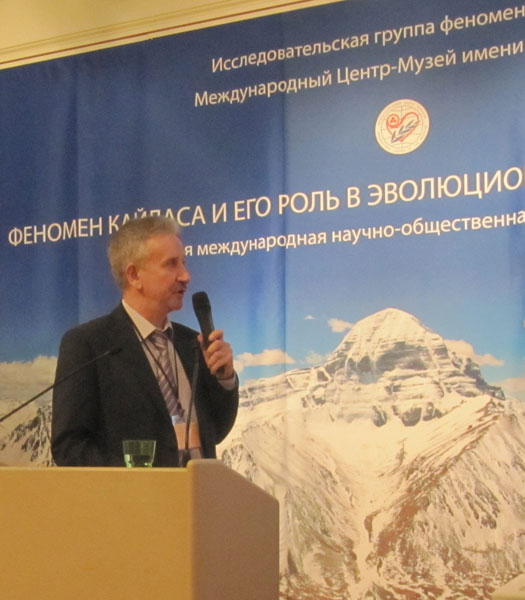 | |
Sergey Balalaev devoted his report "The Great Lakes of Tibet. By the results of expeditions in 2010 – 2014" to the results of three expeditions organized by the author to the Great Lakes region of Tibet, which is so far one of the most remote and rarely visited areas of the Earth. Participants of the expeditions visited a number of large lakes: Namtso, Serling, Kering, Dangra Yumtso, Teri Namtso (Tashi Namtso), La Ngak (Rakshasa Thal) Mapang Yumtso (Mansarovar), as well as a number of small ones, particularly Pangong, Taktse, Tangshung, Takyel. Such artifacts as fortresses, temples, stone pillars, graves, caves, petroglyphs and inscriptions, virtually unknown to Western travelers, were found in that region. For the first time, the region's archaeological monuments which belong to different time slices, were examined. Along the route, several large megalithic complexes were detected - on the northern shore of lakes Namtso and Tashi Namtso, on the southeastern shore of Lake Tangshung, and on the north-eastern shore of Lake Dangra. A lot of caves used by practicing yogis since ancient times were discovered nearby almost every lake. Rock carvings and inscriptions in these caves relating to both the Buddhist and the pre-Buddhist historical periods were documented. Along the northern part of the eastern shore of Lake Dangra Yumtso, there are the ruins of forts, which might have been founded during the time of Shang Shung. They include three fortresses: Kyidsum Gyampai Dzong, Kyung Dzong and Ombu Dzong. Kyung Dzong (the Eagle Fortress) is of particular interest, since it belonged to the last king of Shang Shung – Ligmigya. The nearby Bon monastery Yubung (Turquoise Mist), restored several times (last in 1980), is one of the most ancient archaeological sites on lake Dangra Yumtso; it is famous for the fact that there supposedly is a cave of the soul of the lake deity – Dangra Gyalmo. At the lake Namtso, expedition members visited Cape Nying Do (Cape-Heart) – the location of pre-Buddhist ruins, consisting of about twelve buildings; Cape Tamchok Ngangpa Do (Magnificent Cape Goose Horse), where the monastery Tamchok (Main Horse) is located; Tanglai Gyago – a rock formation with a huge arch, located on a rocky platform jutting out into the lake, and others. In 2010, on two of the four islands of Lake Rakshas Tal, expedition discovered pre-Buddhist archaeological sites: the dokhangs Do Ser (of the Yellow Island) and Do Mook (of the Crimson Island). Text sources attest that these islands were a cult center of the most powerful female deity of the Shang Shung kingdom. Drablai Gyalmo was the queen of the warrior spirits as well as the dual spirits of heaven and earth. The fact of visiting her geomantic "heart" was considered a great blessing in all times. Mr. Balalaev also spoke about the tasks of the expedition "By the Great Lakes to Kailas" planned for 2015.
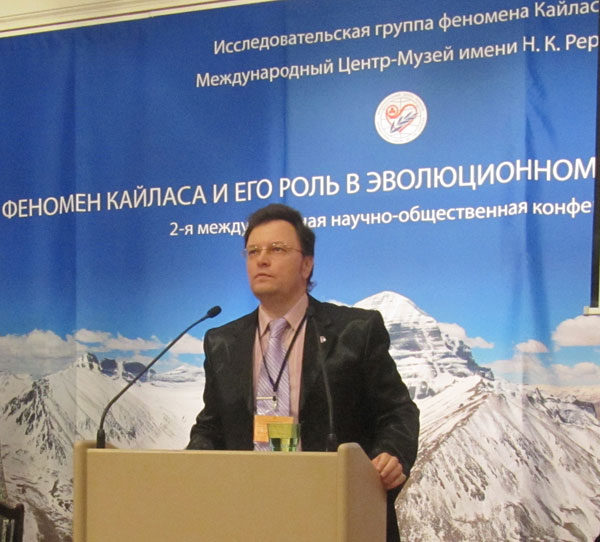 | |
Vladislav Sokolov in the report "Scientific discoveries of the Roerichs in Tibet. (The problem of searching the provenance and ways of resettlement of ancestors of the Indo-European peoples)" examined and analyzed the important scientific discoveries made by the outstanding historian, artist and philosopher Nicolas Roerich and his eldest son, Orientalist George Roerich on the route of the Central-Asian expedition and, in particular, during its Tibetan stage. In spite of the extraordinary complexity and hardships that appeared at this stage, the Roerichs made some very important scientific discoveries. In particular, in the Bon monastery Sharugen, they found a collection of manuscripts, some of which were related to the Bon version of the heroic epic about the great King Geser. The speaker highlighted the features of the ancient pre-Buddhist Tibetan Bon faith. It was noted that sacred places of original Bon were similar to the type of worship (as well as the beliefs) that existed in ancient Germanic tribes. Nicolas Roerich noted the similarity with the style of the Druids (Celtic priests) inherent in ancient images related to pre-Buddhist Bon. He displayed the scenes from ancient drawings on his canvases as a milestone in the study of the Great Migration. When discovering menhirs and cromlechs in the Trans-Himalayas, Nicolas Roerich recalled prehistoric Druids, marking thereby the traces of the ancient inhabitants of Western Europe in the area of the Himalayan range. The speaker revealed a problematic situation in historical science related to the formation of Celtic ethnicity and culture. Professor Sokolov also elaborated on such an important discovery of the Roerichs as megalithic monuments in the Doring area related to pre-Buddhist Tibet and built on the same plan as the famous megaliths of Carnac in France. Nicolas Roerich called the megaliths of Doring “an undubitable sign of the Druid antiquity”. Since the megalithic structure of Doring was devoted most likely to a solar cult, the speaker dwelled on the significance of this cult among the ancient Aryan tribes. The signs left by ancient settlers testified of the former cultural unity. These signs were found by the Roerichs in rock paintings, "animal style" of ornaments and decoration of weapons, megalithic monuments, burials, anthropological comparisons, linguistic parallels, nomadic legends, etc. Those marks being so similar, unified very remote regions of the Eurasian continent and outlined the roots of the Great Migration that took place many centuries ago and covered Tibet, Ladakh, Lahul, Kashmir, Northern Mongolia, Altai, southern Siberia, the southern Russian steppes, the northern Black Sea, Scandinavia and Western Europe. So, the area of the Himalayas could have been the starting point of these great migrations. Especially important is the fact that the ancestors of the Indo-European peoples were involved therein.
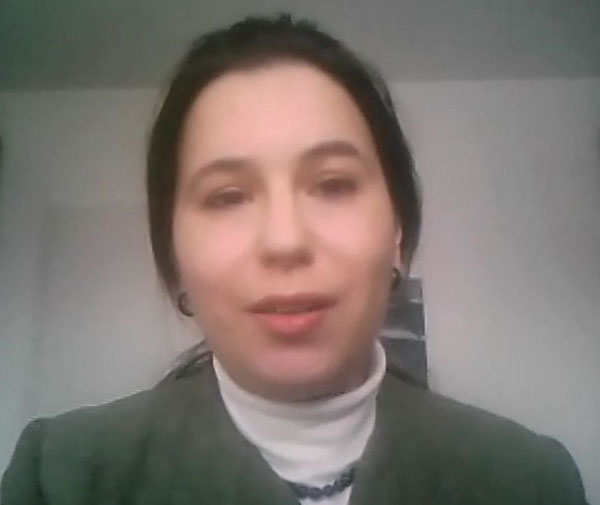 | |
Marga P. Kutsarova (Bulgaria, Sophia), a post-graduate student of the Sophia University named after Kliment Ohridski, Head of the branch of ICR in Bulgaria, Chairman of the National Roerich Society, Laureate of the International Prize of Helena Roerich, in her report "Hindu mythology about the earthly abode uniting the worlds" pointed that according to Indian mythology, there are three worlds which form the universe – the world of men, the world of the gods and underworld. These three worlds are closely interrelated, and the gods serve as link between the worlds. The sages, or messengers, also unite the worlds, they wander between heaven and earth, telling people the will of the gods and predicting the future. There is a place on the Earth where earthly and heavenly worlds are very close. Such a place, according to Indian mythology, is the Himalayas – the abode of the divine sages. There is also a sacred place at Kailas, called the abode of Shiva, where the two worlds are united into one. In Hindu mythology, one can find the designation of a secret place in the Himalayas similar to the abode of Shiva, where the worlds come into contact. This is Uttara-Kuru, or Northern Kuru.
 | |
According to the ancient Indian epic, it is the residence of the gods and sages. Modern scholars who have studied the Kalachakra teachings believe that the Buddhist image of Shambhala correlates, above all, with Uttara-Kuru of Hindu mythology, as well as the abode of Shiva. This dual reality of the sacred land, indicated in Hindu and Buddhist mythologies as well as historical literature of Tibet, is of great challenge for modern conventional science, for its epistemology and methodology. This dual reality, or the union of two worlds in one space, is described and viewed by modern conventional science, at best, as a feature of mythological and historical sources, but it is absolutely not taken into account in research. That is, conventional science offers two approaches. The first one is historical, according to which Shambhala, or the cherished country, was a real country in history, but all the unusual characteristics of the country and its inhabitants, especially the features of the dual reality, are completely discarded. Another approach focuses on the unusual characteristics of the Sacred Land that are represented, as a rule, by mythological images, and ignores the details of the real earthly existence of the land of Shambhala. Here, the Sacred Land is no more than the fact of mythology. Shambhala, or the sacred Abode of the Great Sages, does not fit with its multi-dimensionality into the Procrustean bed of modern science which can not explain why, for example, Shambhala has always been considered by the peoples of Central Asia as real. The problem of duality, or union of two worlds in the space of the Sacred Land, finds its solution only within the new science, based on the system of knowledge and methodology of the new cosmic thinking displayed in the philosophy of real cosmos – Living Ethics. According to it, Shambhala is a unique place on the Earth and is related to the cosmic evolution of mankind.
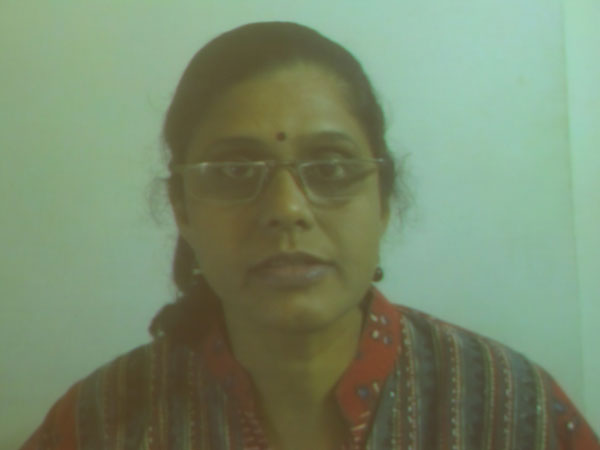 | |
Sumathi Chandrashekkhar, (India, Bangalore), a traveler, spoke on "The Call of Kailas – an insightful journey. Kailas parikrama experience from the perspective of Indian pilgrims." (“Parikrama” is the Indian for “kora”, a pilgrimage walk around the sacred place). In her report, Sumathi Chandrashekkhar described her way to Kailas which she called a spiritual journey. Sumathi together with her fellow-travelers started the route in Lhasa and headed to Mount Kailas and Lake Manasarovar. According to her, something important happened in her inner world during this journey. Difficulties and obstacles along the way were a test for patience, faith and willpower. Here it was important to maintain the unity of the group of pilgrims and positive energy. The traveler told about her impressions when making ablution in Manasarovar lake where she felt sublime atmosphere. She also mentioned about a special place where, when passing by, a person gets released from negative emotions and habits. "The mountains were like my teachers, they taught me to be as calm and contemplating as they were" – shared with the audience Sumathi Chandrashekkhar, whose story was full of spiritual experiences and transformations that happened to her on the way to Kailas and near the mountain. Such spiritual experience of the pilgrims to the sacred mountain is of considerable interest for scientific research.
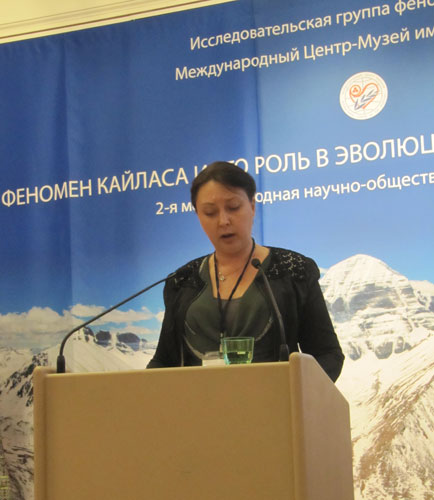 | |
 |
Galina V. Kotovskaya (Russia, Voronezh), a traveller, a member of the Research Group of the Kailas phenomenon, in her report "The sacral meaning of Kailas kora (a pilgrimage circuit)" examined nine koras around Mount Kailas. Kora is a ritual circumbulance of a sacred place clockwise or counterclockwise. The most frequent kora of Kailas is Outer Kora (length of about 50 km), the highest point of which is Drolma La pass (5642 m). Hindus and Buddhists make kora clockwise, while the followers of Bon – counterclockwise. The route of Inner kora (Dakini kora) differs from Outer kora in initial and middle sections and passes through the pass Khandro Sanglam La (5685 m). The path of another inner kora, Nandi-kora, takes place at a much greater height than the path of the Outer kora (5300–5850 m). The kora of Touching Kailas Faces is realized in successive approaches towards each of the four Kailas faces, touching them and implementing some specific practices. Integral kora is a gradual circuit of Kailas by a group of people, first counterclockwise and then clockwise. Vajra kora is made by passing the northern (counterclockwise) and southern (clockwise) inner koras. Dzogchen kora is made by two people, the first person (woman) moving counterclockwise and the second person (man) – clockwise. The meaning of the kora of Merging Elements is to harmonize human energy system through the Faces of Kailas, each of which corresponds to a particular element. In conclusion, Galina Kotovskaya described the route of the ninth kora – the Spiral kora, which consists of three parts and includes visiting of all five lakes located near Kailas.
Olga V. Karasyova (Russia, Moscow), Culturologist, Orientalist, Sinologist, researcher of the USC CTP of ICR, in her report "On the problem of interpretation of Meru and Kailas in Indian sources" considered the paradigm of mountains in sacred geography and the concept, common to many cultures, of mountain as the axis connecting the worlds or the abode of the gods. In the light of this paradigm, the concept of Meru is a certain ancient archetype typical not only for the Indo-Aryans, but also for other ancient cultures. The report examined the description of Mount Meru as the central point of the world found in classical sources, such as Taittiriya aranyaka, Valmiki Ramayana, the Mahabharata, Vishnu Purana. Mentions of Kailas and Meru in one and the same text, such as the Mahabharata, probably belong to different layers of the text. All the sources indicate the location of Meru in the north, beyond the Arctic Circle. Basing on the analysis of texts, researchers come to the conclusion that Meru peak is meant to be the magnetic North-South axis and the direction to the North Star. Mount Kailas, being a natural mandala, took over the function of organization of sacred space, having become the archetypal symbol of Mount Meru in the sacred geography of India.
 | |
Denis V. Myachenkov (Moscow, Russia), producer of DATTA MEDIA Group, in the report "The meaning of the pilgrimage to Kailas from the perspective of Vedic tradition" considered some features of Vedic tradition and pointed out that Vedic culture comprises the spiritual way that enables humans to realize their Divine Essence. Vedic culture is the most ancient on our planet, and we often discover its marks on the territory of Russia. Some scientists believe Sanskrit to be the protolanguage for Russian language. A pilgrimage to Kailas is unique because it gives impetus that has a positive impact on the spiritual growth of a person. The rapporteur outlined his own travel experience to Kailas, stressing that the road to the mountain is a sacral journey, and it is associated with many difficulties and obstacles. But if person's mind is pure and open, he or she will overcome any obstacles on that way. In conclusion, the speaker shared his personal experience of preparation for the pilgrimage to Mount Kailas..
22 March 2015, Evening session
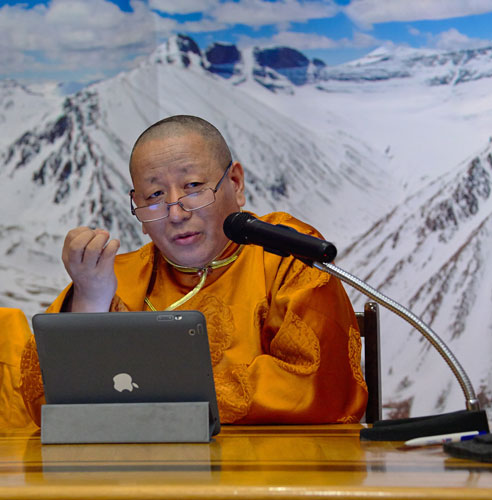 | |
Lama Yonten Gialtso (India), an honorary participant of the conference, abbot of Jonang Takten Phuntsok Choeling Buddhist Monastery, Doctor of Tibetan medicine, presented the report "Mount Kailas in Tibetan Buddhist tradition". Lama Yonten Gialtso was trained at the monastery Ser Gompa of Jonang tradition, where he successfully completed the practice and passed the exams in the Kalachakra teachings. Many years he spent in meditation in the caves of the great Tibetan saint Milarepa and other places of reclusion, where he practiced Kalachakra Tantra. In his speech at the conference, Lama Yonten Gialtso noted that Mount Kailas revered as the heart of our planet has a great meaning in Tibetan Buddhism. It is believed that sixteen Arhats – disciples of the Buddha who attained enlightenment, are dwelling on this mountain. An important aspect is that Kailas is a dwelling place of the deity Chakrasamvara. Lama Yonten Gialtso spoke about tantra Chakrasamvara and the so-called practice of deities: peaceful deities help to develop positive qualities, while angry ones – to eliminate the negative features. The practice of Chakrasamvara takes place at Kailas, where such spiritual practices are much more powerful than in other places. The Tibetans believe that Mount Kailas has a great power and energy and is able to transform negative emotions and eliminate the disease. Lama spoke about the vital energy of man (la), that it must be protected; the loss of energy occurs when a person focuses only on the external objects, which may lead to weakening and the emergence of diseases. Kailas, by virtue of its blessing, helps to achieve three kinds of liberation – through visions, through touch and through hearing. Lama Yonten Gialtso also dwelled on the practice of prostrations. In addition, he noted that Tibetan Buddhism draws parallels between Mount Meru and Kailas. Lama told about the spatial structure of Mount Meru, about four continents located around it, and noted that there are four mountain peaks around Kailas.
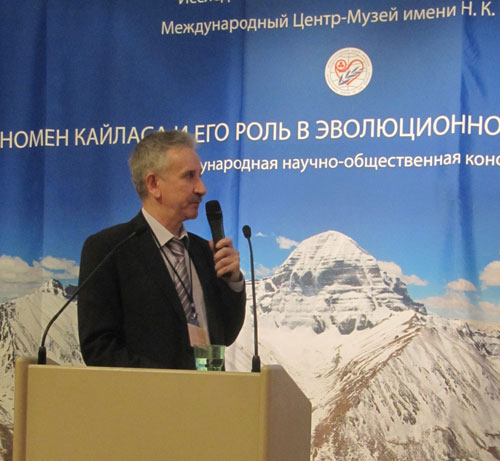 | |
Sergey Balalayev at the beginning of his report "The Tibetan route of the Central-Asian expedition: 86 years later (on the results of the expedition in 2014)" spoke about the Central-Asian expedition of the Roerichs (1924–1928), during which many ancient monuments were discovered and studied, a wealth of ethnographic, folklore and linguistic material was gathered. He also noted the importance of this expedition which, according to the eminent historian and philosopher Lyudmila Shaposhnikova, "created an energy field for formation of future centers of culture." Part of the route of the Central-Asian expedition passed along almost unexplored territory of Tibet. In August 2014, the author of the report succeeded in organizing a unique expedition that went along the routes of the Tibetan part of the Central-Asian expedition of the Roerichs. The expedition of Sergey Balalaev dedicated to the 140th anniversary of the outstanding Russian thinker, artist and scientist Nicolas Roerich, took a huge circuit of about 3,000 km (branching off to the base camp by Chomolungma and to Kailas). More than 200 kilometers were covered on foot at high altitude. Sergey Balalayev said that current routes of Tibetan pilgrims duplicated the ancient migratory way – from Nag-chu through Nam-ru to the sacred Mount Kailas. His expedition visited many places where the caravan of the Roerichs passed, including Nag-chu, near Lake Dongria, the Brahmaputra River, and was engaged in searching for the interesting megalithic complex that the Roerichs first discovered in the area of Doring. On approaching Old Tengri, a number of ancient ruins of forts destroyed during the Tibetan-Nepalese War in XVIII century were examined. The speaker emphasized that these studies can be called pioneer, outlining the contours of future expeditions. Within the presentation that accompanied the report, Sergey Balalaev, along with some chronicle photographs of the Central-Asian expedition of the Roerichs, presented the photographs of the same sites taken in 2014. In 2015, Sergey Balalaev is going to continue his research on the route of the Tibetan part of the Central-Asian expedition of the Roerichs.
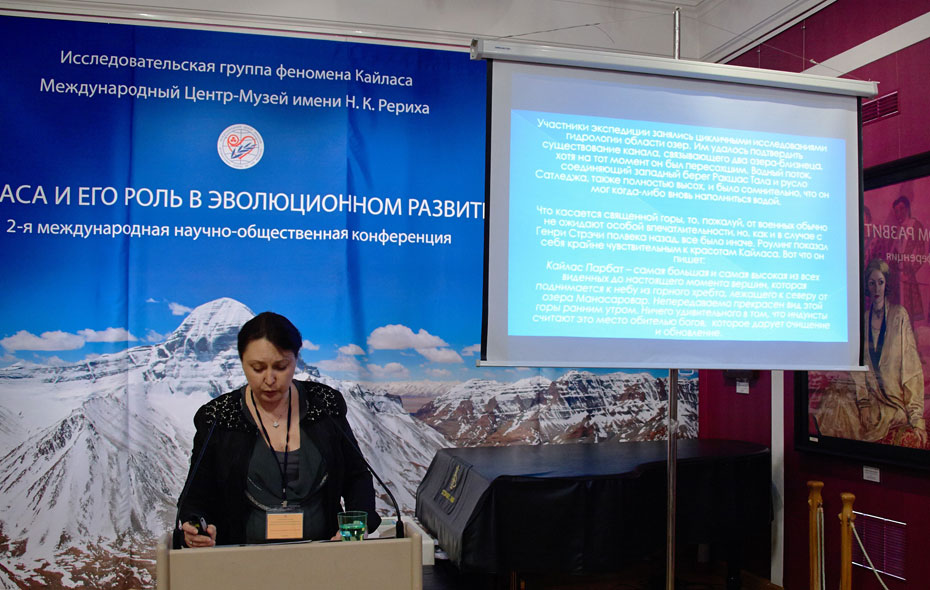 | |
Galina V. Kotovskaya made her report "History of research in the region of Kailas by foreign travelers" in the form of a brief review, focusing on some of the most interesting travel stories. The first of the few Europeans who have seen the sacred peak were Jesuit missionaries Ippolito Desideri and Manuel Freire, who passed near Kailas on their way from Kashmir and Ladakh to Lhasa in 1715. Explorer William Moorcroft, who undertook an expedition to Lake Manasarovar in 1812, was the first Briton visited Mount Kailas. In September and October 1846, Lieutenant Henry Strachey undertook an expedition to lake Raksas Tal, and later wrote "The story of a journey to Cho Lagan". During the second half of XIX century, the influx of travelers to the innermost region continued, but its qualitative status changed: serious researchers and surveyors were replaced mostly by sportsmen and adventurers. In 1855, German researchers – brothers Adolf and Robert Schlaginweit – saw and sketched a part of the Kailas range. In 1897, a Buddhist priest Ekai Kawaguchi from Japan traveled to Tibet and Mount Kailas. Particular attention was paid to the famous Swedish scientist, traveler and explorer of Central Asia Sven Hedin, who studied Tibet from 1893 to 1902. Galina Kotovskaya spoke also about European travelers and explorers of the 1920s – 30s. The last foreigner who visited the sacred mountain before the access to it was closed by Chinese authorities, was the Indian scholar and pilgrim Swami Pranavananda. The study of the region of Kailas and Tibet in whole by foreigners was resumed only in the 80-s of the last century.
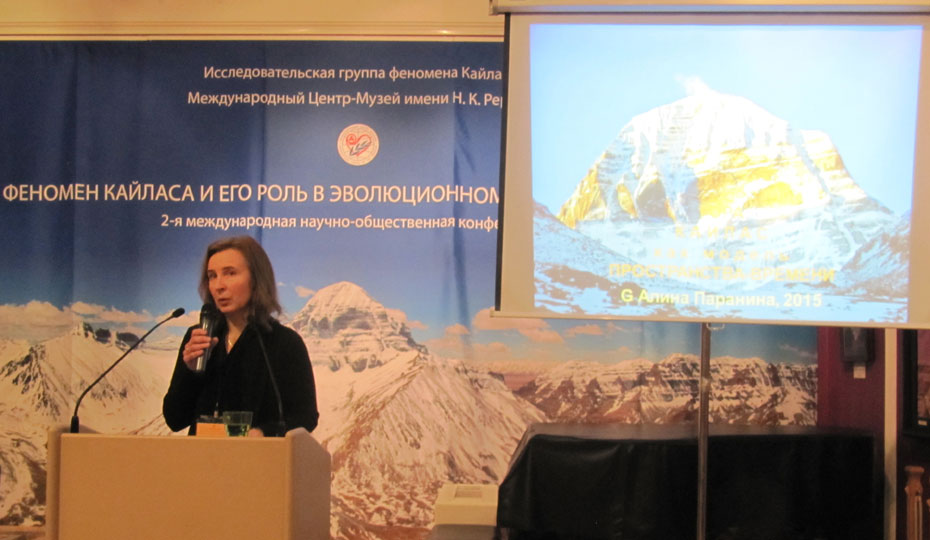 | |
Alina N. Paranina (Russia, Saint-Petersburg), Candidate of Geographical Sciences, Associate Professor of the Russian State Pedagogical University named after Alexander Herzen, in her report "Mount Kailas as a model of space-time" shared her thoughts about this mountain peak as the axis of the world. Speaking about the semiotics of the landscape, the reporteur highlighted that the faces of Kailas turned to the cardinal points, have been of great significance for a man from the earliest times as reliable geographical reference-points for organizing the order of space-time, and therefore – particularly revered. As additional informative resources of the landscape that are important for orientation in space-time, there are ridges and concave bends in West-East and North-South directions in the immediate vicinity of the mountain. Location on the main watershed near the largest rivers of Tibet, India and Nepal – the Indus, the Sutlej, the Brahmaputra and the Karnali – has led to the importance of this place as a crossroads and center of cultural communication; it is no accident that in ancient times, there was the capital city of Shang Shung. Among the famous centers of global significance, Mount Kailas is the leader in durability, preservation and continuity of tradition (landscape guidelines are the elements of most ancient navigation technology, developed in the stone age); in planetarity of metrological standards conserved in the structure of natural and cultural sacral complex; in graphic semiotics of the nature, which found its reflection in the world culture.
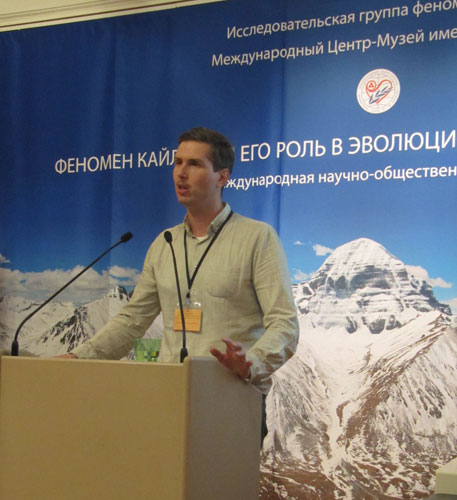 | |
Alexander E. Ivanyuk, the director of Travel Club "Kailas Mandala" (Moscow), in the report "History of inclusion of Kailas Mandala into the Buddhist Tantric pantheon" considered the premises of inclusion of Kailas as the dwelling-place of Shiva (Ishvara, Mahesvara, Rudra) and his spouses into mandalas of Buddhist tantras. The rapporteur presented the content of the original myth (from the collection of Indian texts of VIII century) about the conquest of Mount Sumeru mandala by Vajrapani at the request of the Buddha Vairocana. The continuity of the essence of the myth in Indian Tantras and the development of the myth of the conquest of Mount Sumeru with the replacement of Vajrapani by Sri Heruka, reflected in the cycle Chakrasamvara-Tantra, have been shown. Mr. Ivanyuk pointed out the presence of several levels of understanding the myth: a classic fairy tale, carrying Buddhist values to practitioners of Shaiva and Shakti; at the doctrinal level, especially in the Tibetan version, the myth asserts the interpenetration of all the elements of reality and their interdependence; in the historical context, the myth brings the understanding of external and internal forces affecting Buddhist communities of India and Tibet.
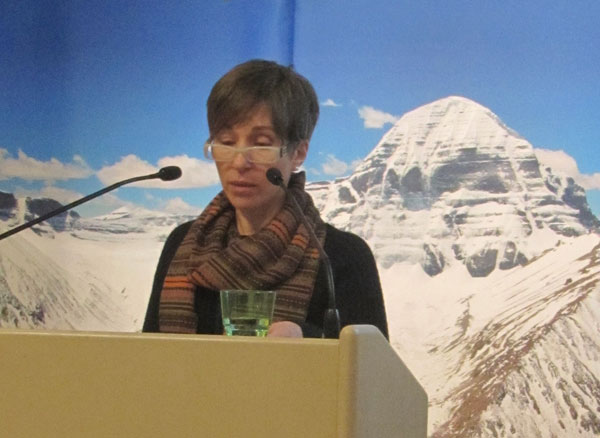 | |
Elena A. Simonyants, Applicant for the Degree of the Southern Federal University (Russia, Rostov-on-Don), in the report "Back to the future: to the foundations of life via the form of spirit" considered philosophical categories such as time, energy and spirit, raised the problem of creation, and noted the negative processes occurring in today's society. A new type of science anticipates a special type of thinking as a result of convergence of science and art; its major mechanisms will be the mechanisms of creativity. Today they are the most poorly studied as eluding from scientific reflection. Awareness of them lies on a deeper level, the level of cosmic flows. The scale, power and significance of these flows are such that humanity can not deviate from them under any conditions, because of the ontological identity with them. An ancient form of storage of these forces for the future of humanity is Kailas. A sort of guidance, a key to comprehension of Kailas is Kalachakra – the ancient system of knowledge about space, time and energy. The ancient hoary Kailas is waiting for maturing human race to tell them the secrets of the Universe.
The round table: "Tibet – Kailas: the first results and prospects for further research" was opened by Victor Frolov. Summarizing general results of the conference, he marked the diversity of positions presented by philosophers, scientists, bearers of religious traditions and travelers concerning various facets of comprehension of the Kailas phenomenon. Despite some differences in terms, they were united by the knowledge gained in the process of philosophical reflection, scientific research, religious experience or involvement into expeditions to Kailas. V. Frolov stressed that we are at the stage of accumulation of material, and we have to form a holistic view of the phenomenon of Kailas, which would be based on the new cosmic thinking and use a new methodology. It is encouraging that some reports have already applied this new methodology. Kailas as a subject of study imposes great responsibility; study of this important region will be convincing if it is based on sources, that is on knowledge, translated by ancient texts, myths and legends. For the development of scientific research of the region, according to Professor Frolov, some conditions are important, among which is the need for basing on the new system of knowledge. Critical to this work are involvement of professionally qualified scientists, good command of European and Oriental languages, among which the leading position is hold by the Tibetan and Sanskrit. Besides, the study of Kailas can not do without experimental and, wider speaking, material and technical base available at scientific organizations in Russia and other countries. There is no doubt that, due to cooperation of researchers and their aspiration to discover new mysteries of Kailas, a more and more complete and holistic picture will be shaping, showing the role of this phenomenon in the cosmic evolution of mankind.
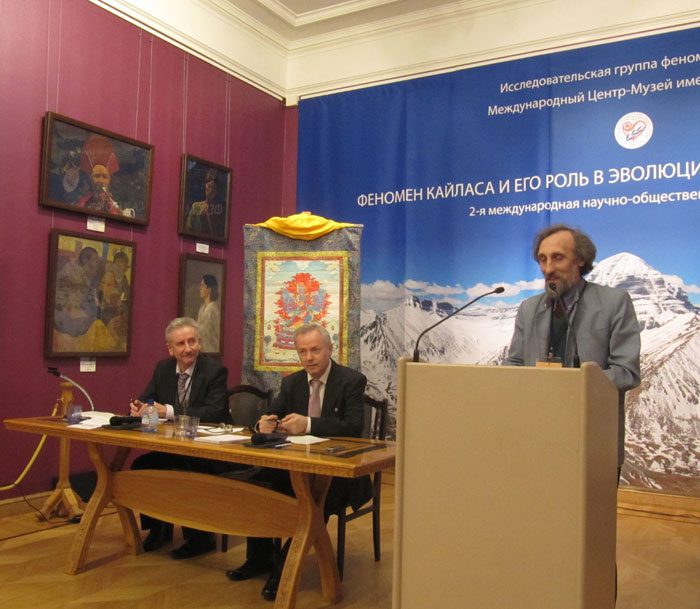 | |
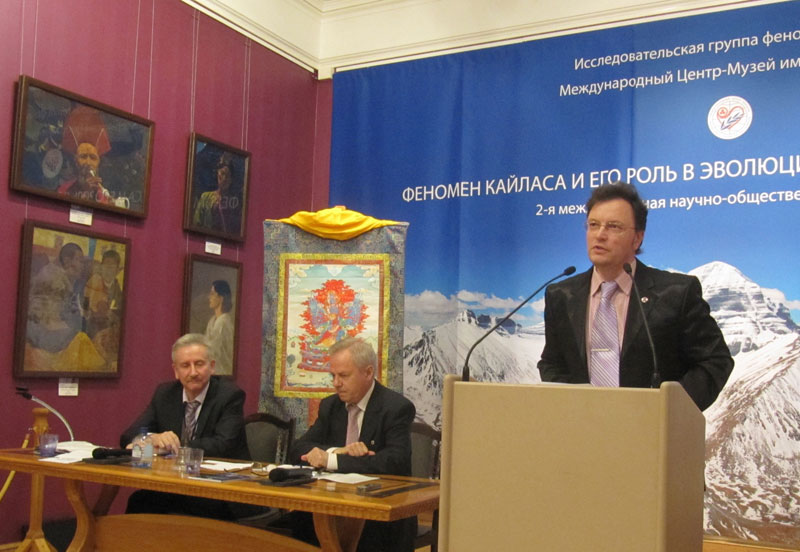 | |
After the speakers answered questions from the audience, they exchanged their views on the results of the conference. According to the leading specialist of the International Department of ICR Areg G. Mekhakyan, a simple circuit around Mount Kailas can not bring to a person the cleansing of karma, for such a purification, first of all, the consciousness expansion and development of the heart are necessary. He said that for self-perfection, one does not have to make kora of Kailas, but only needs to find strength and ways to overcome his or her deficiencies and various obstacles ("mountains" and "passes" in ordinary life) under the circumstances.
Vice-president of the International League for Protection of Culture Mikhail N. Chiryatev (Saint-Petersburg) noted that the wave of interest to Kailas, especially among the Russians, is not accidental in these days, when there is a transition from the old to the new era, when there is an awakening of new spiritual forces in the Universe and in man-microcosm. Furthermore, talking about Kailas, it is no accident that we talk about Mount Meru, since Kailas is one of the reflections of Meru which, according to secret texts, refers to the abode of the gods. Mr. Chiryatev also stressed that, when studying ancient sources, we should apply Helena Blavatsky's "Secret Doctrine" – a unique key that helps us to understand and analyze the secret knowledge.
Vladislav Sokolov summed up the round table and underlined that the level of the Second Conference devoted to the study of the Kailas phenomenon was considerably higher compared to the first one held in April last year which, at the same time, would always remain the first in the world. In addition, he drew attention to the fact that, for developing the main theme of the conference, a broader context should be provided, with approach to the cosmic evolution of mankind, its ancient Races (or species) and the planet as a whole, and it is remarkable that such a broad context has been outlined at the conference. This conference has shown that such an approach is most appropriate, since Kailas itself apparently is included into the planetary system of objects, natural and man-made, essential to evolution of the planet and the human. While studying these objects, we immerse ourselves into the ancient history of mankind. Also, he noted that a number of reports at the conference resonated with nearly all spheres of research activities of the new section "Kailas – Tibet in the light of the cosmic evolution of mankind" at the United Scientific Center of Cosmic Thinking. In addition, Mr. Sokolov said that for comprehension of such a phenomenon as kora (circuit) of Kailas, it is important to explore and understand why certain changes occur to a person during this circuit. For such cases, we can successfully apply the new system of knowledge – synthesis of empirical scientific and meta-scientific methods of cognition. The speaker stressed that for the most qualitative study of the issues raised at the conference, we should involve such a significant source as "The Secret Doctrine" by H.P. Blavatsky. Vladislav Sokolov pointed that, as a result of the conference, a new problem has been outlined which is a need of transition from retelling of a myth to search for a semantic clue to multilayered images displayed there. Study of this problem will open to us great opportunities in research, we will approach to the study of the most ancient layers of human history.
Bohdana Sokolova, Vladislav Sokolov, Alexander Tyurikov.
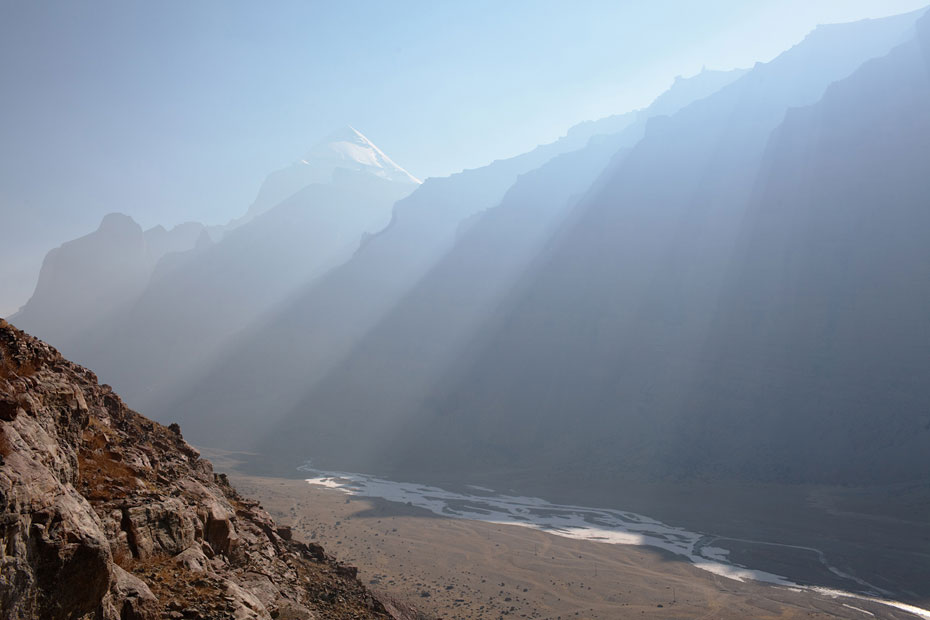 |
The organizing committee warmly thanks all the volunteers for their great help in holding the conference.